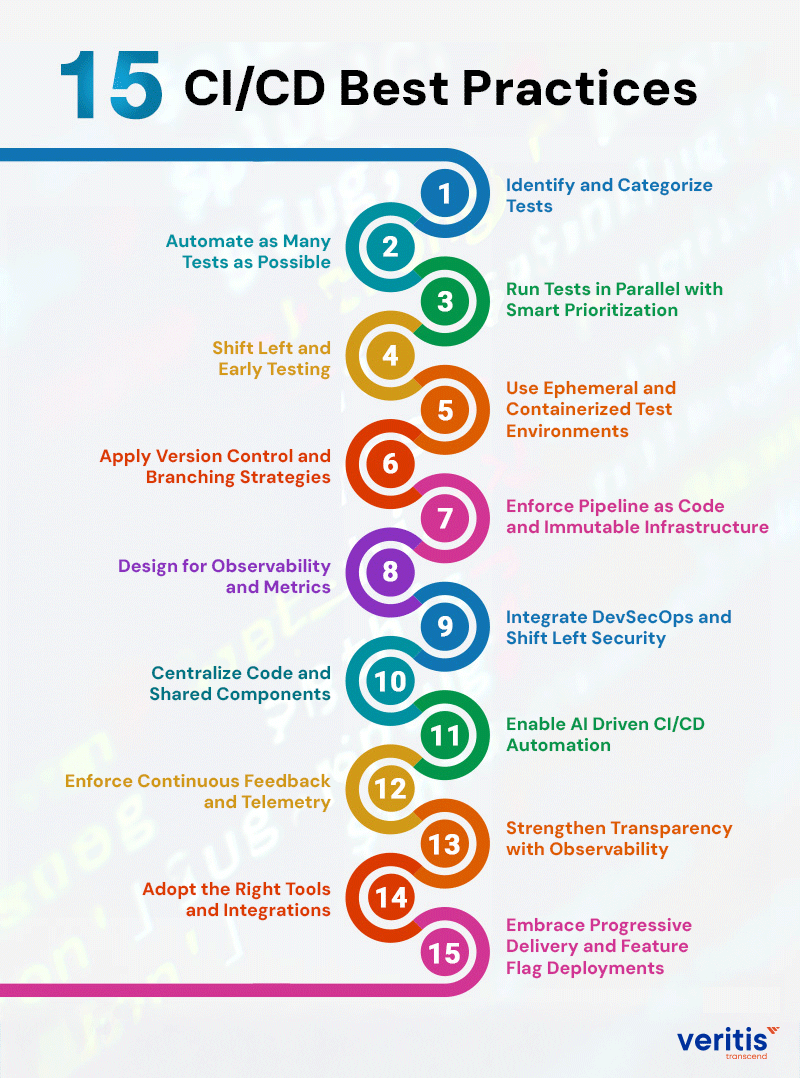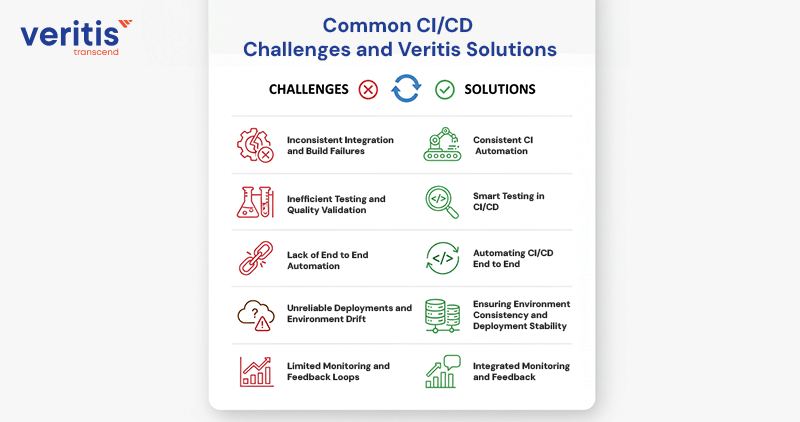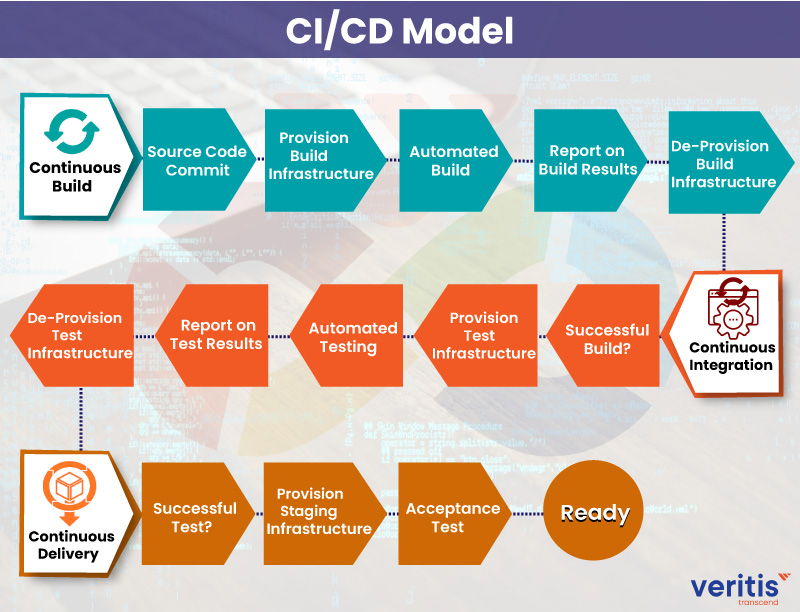
Changing consumer preferences and growing market demands have significantly impacted the software development life cycle. This translated into a rise in demand for faster innovation, leading to early product development, release, and time to market. Different SDLC phases had to accelerate their delivery mechanisms to meet the speed.
And here is where devops automation arrived as an advantage in accelerating and streamlining internal processes. The role of automation is widely discussed in software testing, referred to as ‘Test Automation’ and ‘Automation Testing.’
While ‘Automation Testing’ is a software technique that tests and compares the actual outcome with the expected outcome, Test Automation automates repetitive and other testing tasks that are tough to perform manually.
The continuous integration and continuous deployment (CI/CD) market is experiencing significant growth, with projections indicating it will surge to USD 45.8 billion by 2027, boasting a Compound Annual Growth Rate (CAGR) of 15.7%. According to the State of DevOps Report, this remarkable expansion is driven by the widespread adoption of CI/CD pipelines, with reports suggesting that 86% of organizations are either utilizing or planning to implement such pipelines.
Moreover, the advantages of CI/CD implementation are evident, particularly among high performing organizations, where 75% have fully embraced CI/CD pipelines compared to only 42% of low performing counterparts. These high performing entities report notable benefits, including 50% faster code deployment, 20% higher developer productivity, and a significant 70% failure reduction, as outlined in the XebiaLabs CI/CD Benchmark Report.
Leveraging DevOps automation consulting can further amplify these results by helping organizations design and implement optimized CI/CD strategies. CI/CD best practices play a crucial role in detecting bugs, automating repetitive tasks, improving execution speeds, and reducing the overall time required to test software. However, a successful CI/CD test automation process is a combination of automation and an effective testing strategy.
Get a Personalized DevOps Assessment
Determining Essential Testing Requirements

Determining what to test and how to approach automation in CI/CD pipelines is crucial for efficiency without compromising quality. While automating every test is impractical due to increased execution time, identifying critical unit and integration tests as part of a robust CI/CD testing strategy helps optimize testing efforts. Leveraging DevOps for automation plays a key role in streamlining these processes, ensuring that the right tests are prioritized without slowing down delivery. Unit testing, typically integrated into the CI portion of the continuous delivery pipeline, focuses on specific aspects of code functionality.
1) Entry and Exit Points
Unit tests validate the input and output of code, ensuring correct functionality. By testing individual code components, failures are minimized when the components are integrated.
2) Isolated Functionality
Functions operating independently, such as authentication or calculators in microservice architectures, can achieve 100% unit test coverage. They require no external dependencies, facilitating thorough testing.
3) Boundary Value Validations
Unit tests can comprehensively test code behavior with valid or invalid inputs. This approach avoids exhaustive manual testing by efficiently covering various scenarios.
4) Clear Data Permutations
Code handling precise data inputs and outputs is ideal for unit testing. Complex data scenarios are better addressed at the integration level due to potential challenges related to mocking and performance impact.
5) Security and Performance
While primarily tested at the integration level, unit tests can validate security and performance. Code should handle invalid authentication and injections and perform efficiently. Unit tests help ensure the robustness of individual code levels, contributing to the overall integrity of the system. In essence, strategic unit testing targets specific code components, enhancing reliability while minimizing redundancy in testing efforts.
In essence, strategic unit testing targets specific code components, enhancing reliability while minimizing redundancy in testing efforts.
Useful link: Fortifying Your CI/CD Environment: Best Practices for Defending Against Security Threats
15 CI/CD Best Practices 2025

Here are 15 CI CD Best practices That Enhance Test Automation Capabilities:
A) FOUNDATION: Building the Right Architecture
1) Identify and Categorize Tests
Not all tests need automation. Identify which test cases should be automated based on frequency and complexity. Prioritizing these improves efficiency and aligns with CI/CD automation and CI CD in testing principles.
- Prioritize test automation by frequency and complexity.
- Focus on high value scenarios aligned with CI/CD best practices.
- Outcome: Streamlined testing effort and faster validation cycles.
2) Automate as Many Tests as Possible
Build a robust CI/CD testing strategy by automating high frequency and skill intensive tests. Automation reduces errors and supports continuous integration best practices across the CI/CD pipeline.
- Integrate automation across unit, regression, and integration layers.
- Supports CI/CD testing and continuous integration best practices.
- Outcome: Reduced manual errors, faster release speed.
3) Run Tests in Parallel with Smart Prioritization
Parallel execution reduces testing time and supports large scale environments. Integrate dynamic test selection and parallel runs as part of CI CD pipeline best practices for faster validation.
- Move QA earlier in development using CI CD in testing principles.
- Detect issues before integration, saving cost and time.
- Outcome: Higher code quality and predictable delivery.
4) Shift Left and Early Testing
Start testing earlier in the development cycle to catch issues sooner. Shift left testing integrates QA within continuous integration best practices, ensuring higher code quality and fewer post deployment issues.
- Centralize repositories; implement GitFlow or trunk based development.
- Reinforces continuous integration best practices.
- Outcome: Traceability, easier rollback, and cleaner merges.
5) Use Ephemeral and Containerized Test Environments
Adopt isolated, temporary environments for each test run to prevent configuration drift. Containerization improves reliability and forms a key element of CI/CD best practices for cloud native delivery.
- Define your CI/CD pipeline configuration as code.
- Use immutable infrastructure for repeatability.
- Outcome: Governance, compliance, and consistency across environments.
B) EXECUTION: Accelerating Delivery Through Automation
6) Apply Version Control and Branching Strategies
Use version control systems to manage code changes, rollbacks, and feature branches efficiently. This remains a foundation of continuous integration best practices and stable CI/CD automation.
- Use containerized runners for parallel execution.
- Accelerates validation under CI CD pipeline best practices.
- Outcome: Shorter cycle times, faster go live decisions.
7) Enforce Pipeline as Code and Immutable Infrastructure
Define your CI/CD pipeline through configuration as code. Immutable infrastructure prevents unauthorized changes and ensures repeatable, compliant deployments, a growing trend in continuous deployment best practices.
- Spin up clean, disposable environments for each test run.
- Key to scalable CI/CD automation and isolation.
- Outcome: Reliable tests, fewer environmental conflicts.
Useful link: CI/CD Services – Integrate and Automate DevOps
8) Design for Observability and Metrics
Incorporate monitoring and feedback loops throughout the pipeline. Observability enhances visibility into builds, deployments, and test results, supporting CI/CD testing excellence and continuous improvement.
- Embed automated security scans in the CI/CD pipeline.
- Follows continuous deployment best practices for proactive defense.
- Outcome: Reduced vulnerabilities, audit ready pipelines.
9) Integrate DevSecOps and Shift Left Security
Embed automated security scans directly into the CI/CD pipeline. Shifting security left is one of today’s top CI CD pipeline best practices, ensuring compliance and reducing vulnerabilities early in the process.
- Monitor pipeline health via logs, traces, and telemetry.
- Enables CI/CD testing insights and data driven improvement.
- Outcome: Predictable performance, faster incident response.
10) Centralize Code and Shared Components
Maintain a central repository where all teams can collaborate and access reusable components. This supports traceability, governance, and aligns with continuous integration best practices.
- Establish shared repositories and standard libraries.
- Promotes reuse within continuous integration best practices.
- Outcome: Efficiency, standardization, and reduced duplication.
C) OPTIMIZATION: Scaling with Intelligence and Insight
11) Enable AI Driven CI/CD Automation
Leverage AI and machine learning for predictive build optimization, anomaly detection, and intelligent testing. These innovations enhance CI/CD automation and represent the future of CI CD in testing workflows.
- Apply AI/ML to predict build failures and optimize test suites.
- Enhances modern CI/CD automation frameworks.
- Outcome: Autonomous pipelines that self tune for performance.
12) Enforce Continuous Feedback and Telemetry
Implement automated feedback mechanisms across all stages of testing and deployment. Continuous telemetry supports CI/CD testing accuracy and enforces continuous deployment best practices.
- Automate feedback loops from test to production.
- Core of CI CD pipeline best practices for continuous improvement.
- Outcome: Early defect detection and rapid recovery.
13) Strengthen Transparency with Observability
Replace basic visibility with full observability, logs, metrics, and traces. Transparent pipelines enable proactive decision making and align with enterprise level CI/CD best practices.
- Replace manual reporting with real time dashboards.
- Encourages collaboration through visibility.
- Outcome: Executive insight into delivery performance.
14) Adopt the Right Tools and Integrations
Choose tools that support scalability, cloud integration, and cross platform CI/CD automation. AI powered testing and orchestration tools are now central to CI CD pipeline best practices.
- Choose scalable, cloud native, and AI powered CI/CD tools.
- Key enabler of continuous deployment best practices.
- Outcome: Unified automation ecosystem that supports growth.
15) Right Tooling
Move beyond single click migrations to progressive delivery. Techniques such as feature flagging, blue green, and canary releases are part of advanced continuous deployment best practices that ensure safer, faster releases.
- Use canary, blue green, and feature flag deployments.
- Ensures reliable, zero downtime releases aligned with CI/CD best practices.
- Outcome: Controlled rollout, lower risk, and faster user feedback.
Useful link: Demystifying MLOps vs DevOps: Understanding the Key Differences
Common CI/CD Challenges and Veritis Solutions

Building an efficient CI/CD pipeline is critical for accelerating software delivery and maintaining quality. However, many enterprises struggle to achieve full automation and consistency. Below are common challenges and how Veritis helps overcome them, applying proven CI/CD best practices, automation, and testing strategies tailored to enterprise needs.
1) Inconsistent Integration and Build Failures
Challenge:
Frequent integration conflicts and unstable builds slow down delivery. Poor version control and manual merges cause rework and delays.
Veritis Solutions:
- We apply continuous integration best practices, enforcing automated code validation and consistent versioning.
- Veritis integrates automated build tools and pre commit checks into the CI/CD pipeline to ensure stable, repeatable outcomes.
2) Inefficient Testing and Quality Validation
Challenge:
Limited CI/CD testing coverage and manual QA cycles delay deployment. Lack of automated test orchestration leads to defects in production.
Veritis Solutions:
- We implement CI/CD in testing with automated unit, integration, and regression testing integrated directly into the pipeline.
- Our approach leverages test automation frameworks aligned with CI CD pipeline best practices to ensure faster, error free releases.
3) Lack of End to End Automation
Challenge:
Many teams struggle to achieve complete CI/CD automation, resulting in manual interventions that reduce deployment frequency.
Veritis Solutions:
- We design pipelines with full continuous integration and continuous deployment best practices, automating builds, tests, and rollbacks.
- Veritis enables self service workflows, reducing human error and accelerating time to market.
4) Unreliable Deployments and Environment Drift
Challenge:
Inconsistent environments across dev, test, and production lead to failed deployments and rollback issues.
Veritis Solutions:
- We standardize infrastructure with configuration management tools and container orchestration.
- Our continuous deployment best practices ensure smooth rollouts, automatic validations, and consistent environments across stages.
5) Limited Monitoring and Feedback Loops
Challenge:
Without real time visibility into pipeline performance, issues go unnoticed until they impact users.
Veritis Solutions:
- Veritis integrates monitoring, logging, and analytics dashboards to provide continuous feedback.
- Our pipelines are built on CI/CD best practices, ensuring faster recovery, better observability, and continuous improvement.
Executive Takeaway
By combining automation, governance, and scalability, Veritis helps enterprises build resilient, secure, and fully automated CI/CD ecosystems. Through CI/CD testing and continuous integration best practices, we turn your development pipeline into a true enabler of innovation and speed.
Understanding the DevOps CI/CD Pipeline Model

Case Study Highlight: Accelerating Software Delivery Through CI/CD and Test Automation
A prominent enterprise partnered with Veritis to modernize its software delivery lifecycle, with a focus on implementing CI/CD best practices and integrating automated testing across all stages of development.
Challenge:
The organization struggled with a fragmented development workflow, manual build and release processes, and inconsistent testing practices. These inefficiencies led to prolonged delivery cycles and increased defect rates.
Veritis’ Solution:
Veritis introduced a streamlined CI/CD pipeline backed by automated testing and code quality checks. Key components included:
- Integrated source control, build automation, and continuous integration
- Automated unit and functional testing within the pipeline
- Consistent deployment across environments using configuration as code
- Standardized workflows to align development, QA, and operations
Impact:
- 60% faster development cycles
- 30% reduction in build and release effort
- Fewer bugs and improved release quality
- Increased release frequency and confidence
Explore the full case study: DevOps Approach Quickens Software Development Time.
Conclusion
Implementing these CI/CD best practices for successful test automation can significantly enhance the capabilities of the development, testing, and deployment cycles. By prioritizing automation, collaboration, and continuous improvement, teams can streamline workflows, accelerate delivery, and consistently deliver high quality software. Get your Development and QA teams on board to embrace these best practices and unlock the full potential of CI/CD automation for your organization’s success.
Veritis, the Stevie and Globee Business Awards winner, offers comprehensive DevOps automation services and expertise in implementing CI/CD pipelines tailored to your needs. With our proven track record in delivering innovative IT solutions, we help organizations optimize their software delivery CI/CD processes and achieve their business objectives efficiently. Partner with Veritis to embark on your journey towards seamless automation and accelerated software delivery.